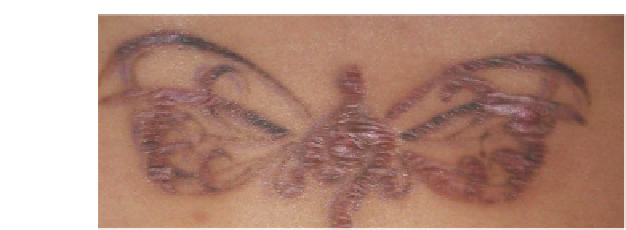Biomedical Engineering Reference
In-Depth Information
thermal damage to tissue (42,123). It was also originally
thought that selective heating of tattoo pigments and their
immediate surroundings would elicit an inflammatory
response and help remove or obscure the pigment. Although
nonspecific heat absorption resulted in diffuse tissue necrosis,
this was thought to be necessary for successful pigment
removal (42).
A histologic study was performed to determine whether it
was possible to oxidize or fragment tattoo pigment, confining
thermal necrosis to a zone immediately adjacent to tattoo
particles and thus avoiding widespread thermal necrosis of
the dermis (42). The argon laser was used with powers rang-
ing from 1.0 to 3.5 W and shuttered pulses of 0.2 seconds and
50 ms in addition to a continuous beam, using a 1-mm spot
size. At 48 hours, subepidermal blisters overlying necrotic
papillary dermal collagen appeared with all treatment param-
eters. At 3 months, fibrosis was present in the papillary and
upper reticular dermis. Pigment-laden macrophages were
present at the junction of fibrotic and nonfibrotic dermis,
with pigment present at a deeper level within the dermis.
Thus, although these authors were able to demonstrate some-
what selective absorption of laser energy by tattoo pigment
(the threshold being 6.25 J/cm
2
for black and red tattoos,
compared with 20 J/cm
2
for injury to normal skin), the 50- to
200-ms pulses allowed extensive diffusion of heat from all
absorbing chromophores, resulting in nonselective thermal
destruction. The inflammatory response was found to be a
minor factor; clinical improvement depended on widespread
necrosis that removed pigment and resulted in fibrosis thus
altering light transmission through the dermis to obscure
underlying residual pigment. Fitzpatrick et al. (179) confirmed
these results and the lack of a specific laser-induced change in
tattoo pigment particles as a result of argon laser therapy.
Although Apfelberg and colleagues (180) reported the argon
laser to be comparable with the CO
2
laser for tattoo removal,
the relatively low-power emission of the argon laser results
in inefficient removal of tattoo pigment, requiring multiple
treatment sessions and a high incidence of hypertrophic
scarring.
Figure 4.5
IPL. Hyperpigmentation, scarring, and ink retention following
multiple IPL treatments of a tattoo.
Abbreviation
: IPL, intense pulsed light.
intense pulsed light
Some novice practitioners have attempted to treat a tattoo
with an intense pulsed light (IPL) device. The pulse duration
of IPL, however, is much longer than the nanosecond times we
see in the Q-switched devices (174) and thus selective photo-
thermolysis does not occur. Instead of being destroyed, the tat-
too ink particles heat up and nonspecifi c tissue injury occurred
resulting in hypopigmentation, hyperpigmentation, ink reten-
tion, and scarring (Fig. 4.5). This source of signifi cant medical
liability is not an acceptable means by which to remove a tat-
too, and the treatment of tattoo ink with an IPL device should
be avoided.
continuous wave lasers
The fi rst medical lasers to be developed were continuous wave
(CW) lasers that, as the name suggests, produced a continuous
beam of radiation that was subsequently absorbed by a target.
Although this constant laser light could effectively destroy tat-
too ink, its use was limited by the fact that the laser energy not
only altered the target but also “spilled over” into adjacent tis-
sue structures, causing unwanted collateral damage including
hypertrophic scarring. Two CW devices that were used for tat-
too removal were the argon and carbon dioxide (CO
2
) lasers.
argon laser
The argon laser uses the noble gas argon as the active medium,
and reports of its use for tattoo removal in 28 patients fi rst
appeared in 1979 (175). Although hypertrophic scarring
occurred in 21% and half of the patients had residual tattoo
pigment, the complete removal of tattoo pigment in eight
patients (29%) with acceptable, reportedly scarless, cosmetic
results led the authors to recommend this laser enthusiastically
for tattoo removal at the time. In their subsequent study, 20 of
60 patients had complete removal of tattoo pigment without
scarring, with amateur tattoos responding slightly better than
professional tattoos (42% vs. 29%) (176). However, hypertro-
phic scarring occurred in 35% of patients and residual tattoo
pigment remained in 67% of patients. Biopsy studies showed
obliteration of the dermis to a depth of 1 mm, and the authors
stressed the preservation of adnexal structures to aid wound
healing and avoid scarring (120,121,177).
The initial use of the argon laser for treatment of tattoos
was based on selective absorption of energy with vaporiza-
tion from its 488 and 514 nm wavelengths by complementary
tattoo pigment colors (121,122,178). However, the clinical
usefulness of this factor is severely limited by melanin and
hemoglobin absorption of laser energy, resulting in unwanted
carbon dioxide laser
The CO
2
laser emits a continuous beam at 10,600 nm, a wave-
length completely absorbed by water, limiting penetration to a
depth of 0.1-0.2 mm. Initial reports of the successful removal
of tattoos with the CO
2
laser appeared in 1978 (123,181,182)
with other reports following soon thereafter (183-186).
Instantaneous transfer of heat from laser absorption by tissue
(cellular) water results in immediate vaporization. The physics
of this interaction was initially misinterpreted to imply that
this always results in confinement of thermal damage to the
30- to 50-mm layer of laser impact. In reality, thermal diffu-
sion can be quite extensive when a continuous beam is used.
Even with pulses of 50-200 ms, great caution must be used to
avoid unwanted thermal necrosis. The original objective in
CO
2
treatment of tattoos was to vaporize tissue containing tat-
too pigment, using visual control to remove all tattoo pig-
ments in one treatment session. Attempts were made to
confine the depth of tissue vaporization to the precise level of
tattoo pigment, which often varies from one portion of the
tattoo to another, resulting in a variable wound depth.















